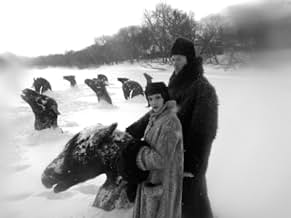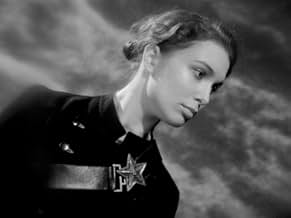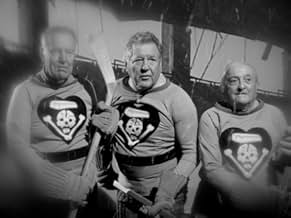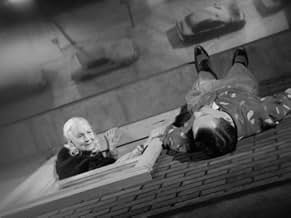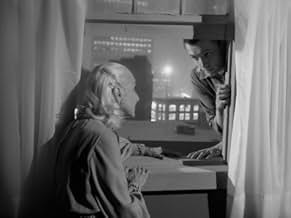NOTE IMDb
7,5/10
5,9 k
MA NOTE
Ajouter une intrigue dans votre langueFact, fantasy and memory are woven seamlessly together in this portrait of film-maker Guy Maddin's home town of Winnipeg, Manitoba.Fact, fantasy and memory are woven seamlessly together in this portrait of film-maker Guy Maddin's home town of Winnipeg, Manitoba.Fact, fantasy and memory are woven seamlessly together in this portrait of film-maker Guy Maddin's home town of Winnipeg, Manitoba.
- Récompenses
- 4 victoires et 17 nominations au total
Avis à la une
Wittgenstein once observed, "Whereof one cannot speak, thereof one must be silent". It should follow on from this wearied maxim that all true art is destined to be personal. Such a truth is evident when watching Guy Maddin's "My Winnipeg". Apparently inspired by the film he shot of Isabella Rossellini remembering her father, "My Dad Is 100 Years Old" (2005) (a documentary of memories - a hyper-documentary? - rather than realities), with "My Winnipeg" Maddin cine-alchemically recreates the patchwork quilt of his life and history of his city, indelibly stained with Winnipegian fluids and woven with Manitoban heart-fibres.
Influences become clear as never before, Maddin's ambisexuality is on display (1995s Sissy Slap Boy Party now makes sense), "La Roue" (1923/Abel Gance) is revealed as his cinematic touchstone (following on from the quotation in "Odilon Redon - or The Eye Like a Strange Balloon Mounts Toward Infinity", also 1995). The movie is almost like a coming out, a cry of freedom, a love letter to all he holds dear, ice hockey, Winnipeg, silent cinema, sexuality, proletarian utopias, family memories. It reminded me of the words of a Portugese man on TV when describing the Carnation Revolution of 1974, where armed forces were conquered by ordinary people wielding carnations, he called it a "giant national orgasm". "My Winnipeg" is Guy Maddin's heart nailed to the screen, as fiercely courageous a movie as you will ever see.
There are blue truths in the film, we're not spared his mother's genitalia or fever dreams of childhood sexuality. Here are some quotations from interviews Maddin gave for this film just so you know what you will be seeing:
"Children are sexual beings, just think of your own childhood. In my case, I was far more sexual as a child than I am now"
"Nothing bothers me more than a movie about the innocence of children! What are they innocent of? They might be innocent of murder, but that's about it! Children haven't learned to repress yet or anything like that. They're just teeming with wonderful luridity, from very early on!"
There is something universal about the film, Maddin incants a litany of opprobrium and indignity that the city of Winnipeg has suffered, from the demolition of an iconic department store, to the closure of two underground swimming pools and the hockey stadia. Modern history is written in the rictus of the agonised city exposed to modernity. Many cities have undergone such outrages, my own city lost it's old centre to Nazi bombing, a fragile heart torn out.
The swimming pools of Maddin's memories are lustful pits, at street level families swim, down one tier the girl's practice mouth to mouth resuscitation on one another, and on the bottom level the boys cavort naked in the changing rooms.
The film transcends documentary, even fantastical documentary into mysticism. Maddin uses the imagery of horses, as have many great artists from Raphael, to Gericault, to Marc, to Parajanov. We see Golden Boy parades, a Masonic town hall, and the two forks under the forks, the mysterious underground rivers that feed the mons veneris on which Winnipeg nestles.
My personal favourite scene was Lorette Avenue where we are show a "hermaphrodite" street where on one side the street has houses facing front, and on the other side the backs of houses. No-one talks about Lorette Avenue (Previously Maddin had made distinctions between alleys where the backs of houses only can be scene, and streets where we only see the fronts of houses).
I won't spoil the ending for you, you have yet to see the wonder of Citizen Girl! Do not waver or hesitate, make ye to the cinema! Maddin has now taken the step from being a beloved cult director, to being a great auteur. Vive le Cinema! Vive la Résistance Culturelle!
Influences become clear as never before, Maddin's ambisexuality is on display (1995s Sissy Slap Boy Party now makes sense), "La Roue" (1923/Abel Gance) is revealed as his cinematic touchstone (following on from the quotation in "Odilon Redon - or The Eye Like a Strange Balloon Mounts Toward Infinity", also 1995). The movie is almost like a coming out, a cry of freedom, a love letter to all he holds dear, ice hockey, Winnipeg, silent cinema, sexuality, proletarian utopias, family memories. It reminded me of the words of a Portugese man on TV when describing the Carnation Revolution of 1974, where armed forces were conquered by ordinary people wielding carnations, he called it a "giant national orgasm". "My Winnipeg" is Guy Maddin's heart nailed to the screen, as fiercely courageous a movie as you will ever see.
There are blue truths in the film, we're not spared his mother's genitalia or fever dreams of childhood sexuality. Here are some quotations from interviews Maddin gave for this film just so you know what you will be seeing:
"Children are sexual beings, just think of your own childhood. In my case, I was far more sexual as a child than I am now"
"Nothing bothers me more than a movie about the innocence of children! What are they innocent of? They might be innocent of murder, but that's about it! Children haven't learned to repress yet or anything like that. They're just teeming with wonderful luridity, from very early on!"
There is something universal about the film, Maddin incants a litany of opprobrium and indignity that the city of Winnipeg has suffered, from the demolition of an iconic department store, to the closure of two underground swimming pools and the hockey stadia. Modern history is written in the rictus of the agonised city exposed to modernity. Many cities have undergone such outrages, my own city lost it's old centre to Nazi bombing, a fragile heart torn out.
The swimming pools of Maddin's memories are lustful pits, at street level families swim, down one tier the girl's practice mouth to mouth resuscitation on one another, and on the bottom level the boys cavort naked in the changing rooms.
The film transcends documentary, even fantastical documentary into mysticism. Maddin uses the imagery of horses, as have many great artists from Raphael, to Gericault, to Marc, to Parajanov. We see Golden Boy parades, a Masonic town hall, and the two forks under the forks, the mysterious underground rivers that feed the mons veneris on which Winnipeg nestles.
My personal favourite scene was Lorette Avenue where we are show a "hermaphrodite" street where on one side the street has houses facing front, and on the other side the backs of houses. No-one talks about Lorette Avenue (Previously Maddin had made distinctions between alleys where the backs of houses only can be scene, and streets where we only see the fronts of houses).
I won't spoil the ending for you, you have yet to see the wonder of Citizen Girl! Do not waver or hesitate, make ye to the cinema! Maddin has now taken the step from being a beloved cult director, to being a great auteur. Vive le Cinema! Vive la Résistance Culturelle!
Guy Maddin described My Winnipeg as 'docutasia' and that's probably more accurate than any other description I could give of it. The film is a very personal, light-hearted, but informative, look at Winnipeg through the eyes of her native son Guy Maddin. The film is shot in black and white, combining stock archival footage (including private home videos) with some new freshly shot material. The film follows a young Guy Maddin (played by Darcy Fehr) on a train trying to escape from 'sleepy, snowing, Winnipeg' and its mystic pull. To affect his escape Maddin must, through the course of the film, come to terms with everything that binds him to the city (family, home, community, and history). Held together by the barest narrative thread, the film is most like Berlin: Symphony of a Great City, though being Canadian it's much funnier and self-deprecating. The film is narrated by Guy Maddin himself, and despite the fact that he seemed to have many reservations about using his own voice, he does a great job (ranging from the fiery sermon of charged propagandist to the soft relaxing repetition of an experienced hypnotist). Made for the documentary channel, with a TV audience in mind, the film is accessible enough for anyone and funny enough to make even Winnipeg charming. While I don't know if it's feature film material, definitely watch if you can catch it on the tube.
You could say that Guy Maddin makes films for the dreamers.
No other filmmaker alive puts so much effort into chipping away at the audience's sense of logic and running them through a grinder of their own twisted subconscious.
Beginning with his feature debut Tales from the Gimli Hospital in 1988, Maddin has remained furiously independent, the closest he's ever come to mainstream success being 2003's The Saddest Music in the World, which acted as a kind-of holy grail for film buffs and those obsessed with the days of cinema past. My Winnipeg may be the purest distillation of his unique aesthetic vision to date, almost surely because it's paradoxically the most personal and fantastical.
In essence, the film is a love-letter to Maddin's hometown of Winnipeg, Manitoba. It's a rueful love-letter though, because the film opens with the director hurriedly explaining that he needs to, has to leave forever. But he can't bring himself to do it. The solution? He'll hire actors to recreate scenes from his childhood, in a desperate attempt to attain some obscure kind of closure. In a fabulously inventive instance of casting, B-movie veteran Ann Savage (Edward G. Ulmer's Detour) plays his "real" mom playing herself.
Maddin augments the often hilarious film-within-a-film with bizarre "facts" about Winnipeg, like how it has the 10 times the sleepwalking rate of any other city or that Maddin himself was born in the locker room of the local hockey arena only to return three days later as a newborn to attend his first game. These half-truths attain a kind-of mythic status when combined with Maddin's haunting visuals that, like most of his filmography, harken back to the choppy, rapid-fire pace of German expressionism and the heart-on-sleeve emotion of '40s and '50s melodrama.
It shouldn't be surprising how funny My Winnipeg is, considering that Maddin might be the most unpretentious avant-garde filmmaker of all-time. His casual, matter-of-fact narration blends perfectly with the film's stark poetic images, making the many leaps of fancy that much more potent. When he describes a "secret" taxi company that operates only on Winnipeg's darkened back streets or ruminates on the beauty of "snow fossils" caused by plodding winter footsteps, it's downright impossible not to be overcome with feelings of deep nostalgia and wonder.
Maddin has made faux-biographical films before, 2006's Brand Upon the Brain the most notorious example, but with My Winnipeg, it feels like he's finally letting us in. Of course, it's just as likely that he's putting us on, and if he is, it's one of the most staggeringly beautiful con games ever committed to celluloid.
No other filmmaker alive puts so much effort into chipping away at the audience's sense of logic and running them through a grinder of their own twisted subconscious.
Beginning with his feature debut Tales from the Gimli Hospital in 1988, Maddin has remained furiously independent, the closest he's ever come to mainstream success being 2003's The Saddest Music in the World, which acted as a kind-of holy grail for film buffs and those obsessed with the days of cinema past. My Winnipeg may be the purest distillation of his unique aesthetic vision to date, almost surely because it's paradoxically the most personal and fantastical.
In essence, the film is a love-letter to Maddin's hometown of Winnipeg, Manitoba. It's a rueful love-letter though, because the film opens with the director hurriedly explaining that he needs to, has to leave forever. But he can't bring himself to do it. The solution? He'll hire actors to recreate scenes from his childhood, in a desperate attempt to attain some obscure kind of closure. In a fabulously inventive instance of casting, B-movie veteran Ann Savage (Edward G. Ulmer's Detour) plays his "real" mom playing herself.
Maddin augments the often hilarious film-within-a-film with bizarre "facts" about Winnipeg, like how it has the 10 times the sleepwalking rate of any other city or that Maddin himself was born in the locker room of the local hockey arena only to return three days later as a newborn to attend his first game. These half-truths attain a kind-of mythic status when combined with Maddin's haunting visuals that, like most of his filmography, harken back to the choppy, rapid-fire pace of German expressionism and the heart-on-sleeve emotion of '40s and '50s melodrama.
It shouldn't be surprising how funny My Winnipeg is, considering that Maddin might be the most unpretentious avant-garde filmmaker of all-time. His casual, matter-of-fact narration blends perfectly with the film's stark poetic images, making the many leaps of fancy that much more potent. When he describes a "secret" taxi company that operates only on Winnipeg's darkened back streets or ruminates on the beauty of "snow fossils" caused by plodding winter footsteps, it's downright impossible not to be overcome with feelings of deep nostalgia and wonder.
Maddin has made faux-biographical films before, 2006's Brand Upon the Brain the most notorious example, but with My Winnipeg, it feels like he's finally letting us in. Of course, it's just as likely that he's putting us on, and if he is, it's one of the most staggeringly beautiful con games ever committed to celluloid.
A love poem to Canadian auteur Guy Maddin's soon-to-be-former home, MY WINNIPEG feels like a fever dream that brings together past, present, and future. Repeated words and phrases form a hypnotic cadence as Maddin's cinematic stand-in (Darcy Fehr) chugs through the snowy darkness. "Winnipeg, Winnipeg, Winnipeg," is the chant, rising and falling like the locomotive drone of the night train carrying its somnambulistic fares through Manitoba's premiere city.
Winnipeg; heart of the heart of Canada, the place that raised Maddin. With a hockey arena for a father and a hair salon for a mother (for more hockey and hairdressing see Maddin's earlier COWARD BENDS THE KNEE), Madding explores the structural arteries of his home town and revisits the history of himself and his city. Narrated by the filmmaker, the prose of the film (courtesy of long-time Maddin crony George Toles) is an overwrought poem of maniacal hyperbole and enthusiastic linguistic gymnastics; a perfect pitch for the fractured visuals of Maddin's multimedia pastiche. Looking like a daguerreotype picture postcard of this snowbound wonderland, MY WINNIPEG typifies Maddin's mad genius and captures his sordid relationship with his home.
Winnipeg; heart of the heart of Canada, the place that raised Maddin. With a hockey arena for a father and a hair salon for a mother (for more hockey and hairdressing see Maddin's earlier COWARD BENDS THE KNEE), Madding explores the structural arteries of his home town and revisits the history of himself and his city. Narrated by the filmmaker, the prose of the film (courtesy of long-time Maddin crony George Toles) is an overwrought poem of maniacal hyperbole and enthusiastic linguistic gymnastics; a perfect pitch for the fractured visuals of Maddin's multimedia pastiche. Looking like a daguerreotype picture postcard of this snowbound wonderland, MY WINNIPEG typifies Maddin's mad genius and captures his sordid relationship with his home.
God bless Guy Maddin. There is nobody else like him. He takes material from the cinematic past and reshapes it in his own completely unique way. He does all this from his own studio in the artistic backwater of Winnipeg. The results are funny, poignant, absurd, and magical. In this he draws on memories of his childhood, family, and community.
Le saviez-vous
- AnecdotesDirector Guy Maddin provided live narration at many film festival screenings.
- Crédits fousTapioca Wrangler - Marnie Patuck
- ConnexionsFeatured in My Winnipeg: Live in Toronto (2008)
- Bandes originalesWonderful Winnipeg
Written by Leon Naleway
Performed by The Swinging Strings (vocal by Jim Wheeler)
Courtesy Shawn Nagy
Played during the opening credits
Meilleurs choix
Connectez-vous pour évaluer et suivre la liste de favoris afin de recevoir des recommandations personnalisées
- How long is My Winnipeg?Alimenté par Alexa
Détails
- Date de sortie
- Pays d’origine
- Sites officiels
- Langue
- Aussi connu sous le nom de
- Winnipeg, mon amour
- Lieux de tournage
- Sociétés de production
- Voir plus de crédits d'entreprise sur IMDbPro
Box-office
- Budget
- 600 000 $US (estimé)
- Montant brut aux États-Unis et au Canada
- 159 363 $US
- Week-end de sortie aux États-Unis et au Canada
- 14 309 $US
- 15 juin 2008
- Montant brut mondial
- 316 743 $US
- Durée1 heure 20 minutes
- Couleur
- Mixage
- Rapport de forme
- 1.33 : 1
Contribuer à cette page
Suggérer une modification ou ajouter du contenu manquant

Lacune principale
By what name was Winnipeg mon amour (2007) officially released in India in English?
Répondre






